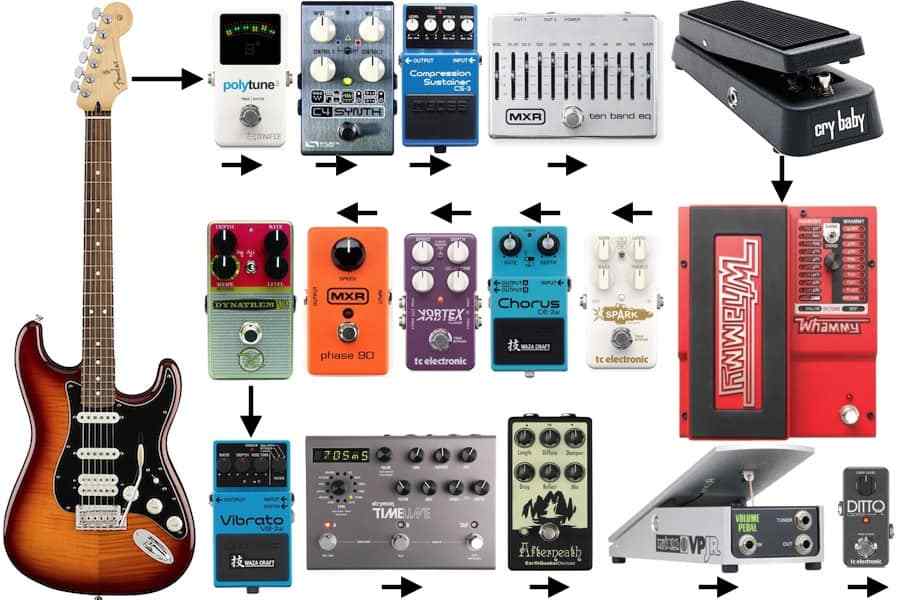Manipulating sound with audio effects is one of the most fun parts of being a producer. There are infinite methods to combine plugins or stompboxes to create a unique sound. The signal chain you select is one method to shape your music in exciting ways. However, how do you know which order to put your effects in? And how will each one impact the next?
In this article, I’ll break down what you should know about signal chains to build your excellent sound. From what signal chain is to the most effective ways to use it, here are all the things you need to know:
What does signal chain mean?
Signal chain refers to the pathway your audio signal takes from its source to its destination. A typical signal chain consists of many audio processors arranged in a specific order to create the desired outcomes.
Signal chains are used for any sound you record live, such as guitars, vocals, drums, and synths played through amplifiers. Once your sound passes through {hardware} like effects pedals, a preamp, or a mixing board, that’s your signal chain.
This additionally applies to the order of plugins within your DAW.
The Signal chain matters because the order of effects shapes the sound in unique and noticeable methods. Each new processor within the chain changes the outcome of the next.
How to arrange your guitar signal chain
Signal chain issues regularly come up for guitarists who use effects pedals. Each category of audio effect plays a role in a guitarist’s rig, and using them together in several combinations is how many players find their sound.
However, deciding on effects pedals order is a bit like the process of writing music. The one that sounds the best to you is what you should go with, so get in there and experiment.
However, there are some common rules you’ll be able to look at to create specific outcomes.
- Compressors, buffers, and tone-shaping pedals are sometimes placed first in the chain
- Overdrives and distortions often come next, apart from the vintage-style fuzz, which should go in front
- Modulation pedals like chorus, phaser, and flanger will go next
- Finally, time-based pedals like delay and reverb go last in order that they won’t be colored by the other effects
Once again, there are not any rules in terms of effects so feel free to try orders that might seem incompatible at first.
That said, one serious signal chain problem is unwanted noise. If a certain effects order is producing excessive noise, it’s an excellent signal that something needs to change.
For instance, distortions, EQs, and compressors placed after something that causes unwanted noise will only make it worse.
It’s a good suggestion to order pedals that add or distort noise early in the chain. It’s because placing them later will affect and enhance everything before them, and you’ll have a loud mess on your hands.
Signal chains for mixing
There’s loads of creative tone-shaping work in mixing, but most of the time you’ll be blending tracks using compression, EQ, and reverb.
Even so, the same ideas are used for signal chains for mixing.
Setting the compressor first in the chain will provide a predictable, level sound for the rest of your effects. When EQ is ahead of every other effect, it distinctly forms and colors every effect that follows.
Hot tip: It’s sometimes difficult to set a compressor’s threshold for sounds with a lot of low ends. If excessive bass triggers your compressors too early, use an EQ in front to reduce or filter it out.
If you’re trying to combine the distinct qualities of two compressions, use serial compression in your chain. It means that you should place two compressions in a row in your signal path.
Whatever chain you decide on, you’ll be able to easily stack, combine and re-order plugins by changing the order of inserts in your DAW mixer channel.
Aux sends and returns
However, there’s more than just inserts in terms of signal chains in your DAW.
Insert chains are serial signal paths. They provide you with plenty of sound combinations when two of the same effects are placed next to each other.
However parallel chains let you split a single sound into two distinct paths. Each path can be used with a special effect chain to offer a full, unique sound.
This is commonly used in mixing for ambiance effects like delay and reverb so you should use your DAW’s mixer channels to carefully blend them in while leaving the original sound intact.
It’s also more efficient. If you want to add processing to a number of tracks and reduce the load on your computer, sends and returns are a great solution.
You’ll be able to easily dial in how much the chain effects affect each track through this method. If you’re producing all the background vocals on a song, for example, sends and returns are an effective way to go.
Experimenting with signal chains
The wonderful thing about signal chains is that there’s technically no right or wrong way to go about it.
If you need pristine, perfect sounds, you’ll be able to arrange the chain to do that. However, if you want gritty and noisy effects, you’ll be able to customize yours to do that as well.
We sometimes forget that music creation isn’t just about chord progressions and melodies. Most listeners don’t know what signal chains are, but they have a huge effect on the way songs sound.
Try more and perfect your signal chains, and your music will work for it.


